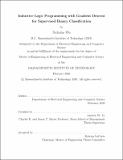Inductive logic programming with gradient descent for supervised binary classification
Author(s)
Wu, Nicholas(Nicholas T.)
Download1237567242-MIT.pdf (414.3Kb)
Other Contributors
Massachusetts Institute of Technology. Department of Electrical Engineering and Computer Science.
Advisor
Andrew W. Lo.
Terms of use
Metadata
Show full item recordAbstract
As machine learning techniques have become more advanced, interpretability has become a major concern for models making important decisions. In contrast to Local Interpretable Model-Agnostic Explanations (LIME), this thesis seeks to develop an interpretable model using logical rules, rather than explaining existing blackbox models. We extend recent inductive logic programming methods developed by Evans and Grefenstette [3] to develop an gradient descent-based inductive logic programming technique for supervised binary classification. We start by developing our methodology for binary input data, and then extend the approach to numerical data using a threshold-gate based binarization technique. We test our implementations on datasets with varying pattern structures and noise levels, and select our best performing implementation. We then present an example where our method generates an accurate and interpretable rule set, whereas the LIME technique fails to generate a reasonable model. Further, we test our original methodology on the FICO Home Equity Line of Credit dataset. We run a hyperparameter search over differing number of rules and rule sizes. Our best performing model achieves a 71.7% accuracy, which is comparable to multilayer perceptron and randomized forest models. We conclude by suggesting directions for future applications and potential improvements.
Description
Thesis: M. Eng., Massachusetts Institute of Technology, Department of Electrical Engineering and Computer Science, February, 2020 Cataloged from student-submitted PDF of thesis. Includes bibliographical references (pages 75-76).
Date issued
2020Department
Massachusetts Institute of Technology. Department of Electrical Engineering and Computer SciencePublisher
Massachusetts Institute of Technology
Keywords
Electrical Engineering and Computer Science.